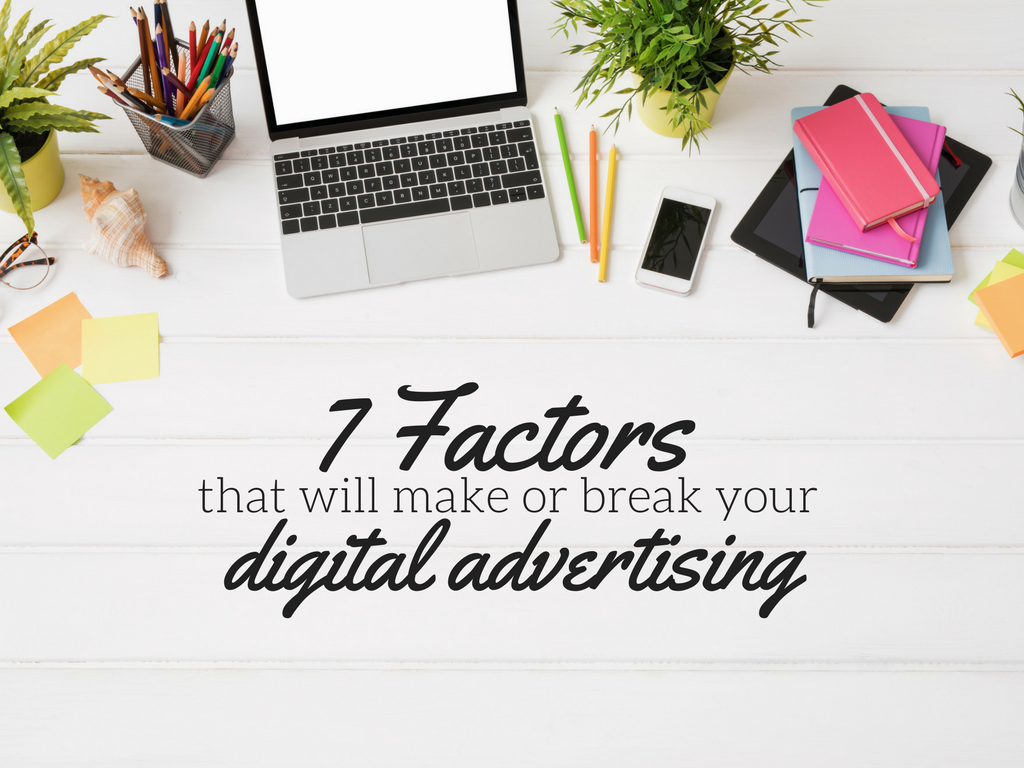
7 Factors That Will Make or Break Your Digital Advertising Campaign
For the first time in history, digital ad spending has surpassed traditional ad spending.
Now this really shouldn’t come as a surprise to anyone. For the past few years, digital has become the darling of many advertisers. Its cost-efficiency, interactive nature and vast audience make digital ideal for brands looking to bump up sales.
However, digital advertising is more than just placing a few banner ads around the Internet and watching sales roll in. In fact, creating a successful online campaign is actually a bit of a challenge. There are a number of factors – from your website to your creative – that will make or break your campaign. Here are seven that you need to be aware of before diving into digital.
1. Your website
Your website is one of the most important elements of your business, not just your advertising campaign. A recent survey found that 75 percent of users admit they decide a company’s credibility based on its website’s design. Additionally, the study also found it only takes shoppers, on average, 2.6 seconds to make a first impression about your webpage. If your website isn’t up to par, your potential customers are going to know it right away. And they’re going to leave without making a purchase.
Creating an optimized, efficient and well-designed website should be one of the first things you do when starting your company. After all, this is the first thing potential customers are going to see. This is your chance to leave a great and lasting impression.
It doesn’t matter if you have the most incredible creative, an amazing sale or a money-saving promo code; if your website looks like an infomercial, your sales aren’t going anywhere. Take the time and make an investment in your website before you move onto advertising. It will benefit you in the long run, we guarantee it.
2. Your research
Once you’ve created a visually appealing and user-friendly website, you can move onto advertising, right?
Wrong.
Before you actually begin advertising (and this goes for both digital and traditional advertising), you need to do your research. Blowing past this step and going straight into running ads is not going to give you the results you want.
This step will truly make or break you. Before you move onto creating and placing advertisements, you need to do some research on your target audience. Who is buying your product? What is your audience’s age range? Are they male or female? This information will help you determine where you’ll run your ads and how they will look.
3. Your creative
After you have an updated website and a stack of research, the fun begins. Now you finally get to start the creative process.
Creating creative isn’t as easy as taking a photo and slapping some text over it, however. Of course, you can do this, but you’re probably not going to see the results you want. When designing your creative, remember that online shoppers are bombarded with thousands of advertisements every day. Your ad needs to be unique to stand out and grab shoppers’ attention.
Your digital advertising should be focused, clear and unified with the rest of your brand. Make sure you use the same colors, logos and typography in your advertisements as on your website, packaging, social media, etc. Your brand should be consistent across all platforms; you want customers to recognize you no matter where they see you. Additionally, make sure you’re using clear, professional product photos. The Internet is full of scams and untrustworthy sites. Don’t give potential customers a reason to think your business falls into that category.
If you don’t feel comfortable designing your own ad, consider working with an advertising agency that will help you design your creative.
4. Your claims
This is a big one, so listen carefully: when designing your creative, don’t make false or misleading claims. It’s as simple as that.
Although it seems somewhat self-explanatory, it happens more than you’d think. It’s easy to claim your product is the best, and promise customers it’ll cure this or remove that, but you should only put claims in your advertising if you can back them up with research. That goes for all forms of advertising. Not only can you get in serious trouble for making false or misleading claims, but your advertising will also suffer if you use false information. You might not know it, but networks like Google will actually flag ads with misleading claims and prevent them from running.
If you’re on the fence about making a claim in your ads, it’s best to just leave it out.
5. Your changes and updates
After you’ve done your research, created a visually appealing ad, and removed any false or misleading claims, it’s time to go live. But don’t think the process ends here.
Just because your advertisement is live doesn’t mean you get to forget about it and wait for the sales to roll in. Oh, no. There’s still a lot of work to be done. Now you need to monitor your campaign, check its stats daily, and watch how it’s performing. You might see great results on this website, but poor results on that website. Or you may notice that Advertisement A is attracting a majority of the clicks, while Advertisement B isn’t doing too hot.
You need to stay aware and informed of how your advertisements are doing so that you can make changes and updates to improve your end results. One of the greatest benefits of digital advertising (compared to print, outdoor, etc) is that you can make changes to your campaign even after it’s gone live. If a certain ad or website isn’t performing the way you had anticipated, you can make changes along the way. Just make sure you’re constantly keeping an eye on your campaigns and are willing to make necessary updates.
6. Your questions
When planning, designing and launching an advertising campaign, don’t be afraid to ask questions. This is especially true if you’re working with an advertising agency. You might not be an expert at digital advertising, but chances are the digital contact you’re working with is. He or she is there specifically to answer all your questions from the best sites to run on, to the creative that’s going to get you the most clicks.

Don’t be afraid to ask your agency contact questions. Asking questions is the best way to find out how to improve your campaign.
Gather all the information you can before launching your ads. If you don’t understand something, ask. If you want to know how a particular process works, ask. Knowledge is power in the world of advertising, and the more you know, the more likely you are to succeed.
7. Your end result
Once your campaign is over, you will receive (if you’re working with an agency) a report of its statistics. Take some time to look over this report and study what happened during your campaign. Again, if you don’t understand something, there’s no shame in asking questions. You want to be knowledgable about your advertising and what happened during your campaign. If you’re confused, ask your agency contact to explain the report to you.
After reviewing your report, you may realize things didn’t go exactly as you had planned. Don’t write this campaign off as a failure just yet, though. Take these numbers and results into consideration and work with your agency to find out what can be improved and changed for your next campaign. One 30-day campaign is seldom long enough to see great results. Often times, this should be looked at as a trial run to see what works and what doesn’t. After that campaign ends, you can see what worked best and apply it to the next one. Don’t get discouraged if you didn’t immediately see the results you had hoped for. Advertising is all about testing and improving. Use your end results as a starting point for your next campaign and make this one even better than the last.
Digital advertising is more than a few keywords and a banner ad. It requires a lot of thought, planning and consistency. With the right approach, however, it can become your business’s best investment.

